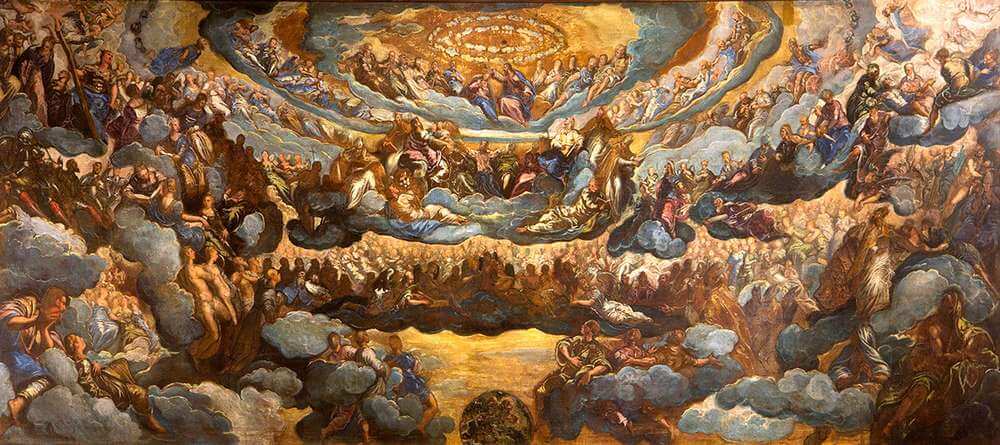The Old Whispers to the Contemporary Words of Truth, Virtue, and Beauty
Author | Agata Brusegan
4/1/2022
Paradise, Oil on Canvas, 154x350cm, 1588, by Jacopo Tintoretto (1518-1594), I.P.A.V. Collection
Cen Long’s dialogue with Jacopo Tintoretto’s Paradise creates a timeless realm where the boundary between illusion and reality is blurred. This exchange not only reveals the Western perception of heaven as the moment of anticipation before the Final Judgment but also conveys the enduring spiritual essence of Dante’s Divine Comedy, which has profoundly influenced generations since the 14th century. This great poet had a profound impact on European thought, and after him, perhaps only Dr. Sigmund Freud (1856–1939) could be considered his equal.
In Paradiso, the final part of The Divine Comedy, Dante ascends through the celestial spheres and reaches the highest part of heaven, the Empyrean. This realm is as pure as fire, not composed of matter, but existing as a spiritual world beyond time and space. God, angels, and the blessed reside in this supreme paradise. The blessed souls sit on the grand steps of a vast circular amphitheater, which Dante refers to as the Candida Rosa ("Pure Rose"). In this world, everything is dazzlingly bright and immaculate.
The influence of Dante is clearly evident in Tintoretto’s Paradise. At the center of the composition is a vast concentric structure formed by the Supreme Being, with the Virgin Mary crowned by twelve stars. Light radiates outward from the figures of Christ and the Virgin, growing in intensity and expanding space to an infinite distance, while the colors become increasingly transparent. Additionally, an illusory, circular, and concentric space emerges, where angels and the blessed are caught in a rotating, ascending movement, breaking free from the laws of gravity. Their domain is depicted as an amphitheater, surrounded by swirling clouds that form colossal steps leading toward the divine light. At the very center or the highest point—essentially the same in heaven—lies the Empyrean, the dwelling place of God, where absolute stillness reigns. A little further down, we observe the Virgin Mary, positioned at the gateway to heaven, where Christ crowns her. Mary represents the connection between humanity and the Holy Spirit; she is the threshold that links divine love with human love, heaven with the earthly world.
This abstract conception of humanity aligns with Cen Long’s artistic philosophy. He believes that despite the passage of time, the changing of individuals, and the shifting of historical events, the ultimate truth of human nature is defined by the eternal pursuit of truth, goodness, and beauty as found in heaven. Through this exploration, one can perceive the connection between divine love and human love. The highest reaches of heaven and the earthly world below are inherently linked. His works reflect the spiritual anxiety of Mannerism, evoking natural forces released into a spiraling ascent, encompassing all who experience them.
Looking back at Tintoretto’s later style, we see its continued intensity, characterized by a stark and uncompromising realism. Through this approach, he decisively broke away from the mythological tendencies of Titian (Tiziano Vecelli, 1488–1576) and the established aesthetic norms of Venetian painting. He pioneered a new poetic language and set a paradigm for future generations of artists.
The art critic Vittorio Sgarbi considers Tintoretto’s work to be one of the earliest examples of Expressionism. He states: "Tintoretto created a painting of intense colorism, narrating the suffering of humanity with profound emotion… ultimately transforming it into a pursuit of truth."
Following the devastating fire that struck the Doge’s Palace in 1577, a public competition was held to replace the fresco Mary’s Crowning. This fresco, commonly referred to as Il Paradiso, was originally executed by Guariento di Arpo (1310–1370) around 1365, but was tragically destroyed on the night of December 20 that year.
This competition, which can be traced back to 1582, saw several of the most prominent painters in the Venetian art scene vying for supremacy. Among them were Paolo Veronese (1528–1588), Francesco Bassano the Younger (1549–1592), Jacopo Palma il Giovane (1549–1628), and Tintoretto. Each dedicated significant time and effort to making a contribution to the restoration of the Doge’s Palace. The palace’s interior was restored soon after the fire, as the Venetian Republic sought to reclaim its former splendor in the shortest possible time, if not surpass it altogether.
The committee overseeing the project meticulously planned the iconographic content. They wished to maintain the same subject matter as Guariento’s lost fresco—the Crowning of the Virgin in Heaven. Additionally, they envisioned an ethereal depiction of the Doge’s celestial court, imagining the Holy Trinity (represented by a dove) radiating divine light in perfect vertical symmetry with the head of state.
Among the competitors, Veronese and Tintoretto were the oldest and most esteemed, while the younger artists Bassano and Palma also participated. There is speculation that Federico Zuccari (1539–1609) may have been involved as well. Each artist presented a distinct interpretation of the theme, with compositions and aesthetic approaches varying significantly. Every proposal showcased a unique artistic vision, making the selection process particularly difficult. Ultimately, the project was awarded jointly to Veronese and Bassano. However, following Veronese’s death in 1588, the situation became increasingly complex. Six years had passed since the commission had been granted, yet the project remained unfinished. How was this deadlock to be resolved?
Although there are no official records of the project being reopened for proposals, it is widely believed that Tintoretto took the initiative. His deep commitment to the work stemmed from his recognition that this would be the crowning achievement of his long career, marking his ultimate victory and securing his place as Venice’s foremost painter after Titian. He introduced a new visual language, significantly refining the approach that had been underappreciated in 1582. His new stylistic direction was strongly influenced by the artistic mandates set forth by the Council of Trent, which aimed to counter the excesses of the Reformation through stricter artistic guidelines.
However, the committee was unimpressed with Tintoretto’s preliminary sketch, finding its dramatic intensity and naturalistic depth overwhelming. The initial oil sketch differs considerably in scale from the monumental work seen in the Doge’s Palace today. Due to its immense size, the painting was completed in sections and required the use of the Scuola della Misericordia, a 15th-century monastery hall, as a workshop. This venue was conveniently located just steps away from Tintoretto’s personal studio.
Much of the physically demanding and labor-intensive work was executed by Tintoretto’s son, Domenico Tintoretto (1560–1635), who introduced ideas that at times diverged from his father’s vision. In fact, once the preliminary sketch was approved, Tintoretto himself seemed less involved in the execution of the final painting, leaving much of the remaining work to his son.
Upon entering the vast Great Council Hall of the Doge’s Palace, visitors are immediately greeted by a long wooden platform lining the eastern wall, serving as an extended bench. Here, the Doge would sit in the center, flanked on both sides by his advisors. The Great Council was the heart of political power in the Venetian Republic. It was responsible for appointing the Doge and all other officials and held the highest authority in governance.
From 1297 onward, during what was known as the Serrata (Great Council Lockout), the number of members was fixed at 1,200. From that point forward, only those whose families were listed in the Libro d'Oro (Golden Book)—approximately 200 aristocratic families—could take a seat in the council upon reaching the age of 25. However, from 1592 onward, this ancient seat of power, occupied by the Doge and the Republic’s ruling elite, found itself overshadowed—both physically and symbolically—by Tintoretto’s monumental Paradise, a vast 22 x 7-meter canvas that dominated the hall.
One might ask: why is Paradise, a sacred subject, positioned at the heart of one of the world’s most secular states?
The answer lies in its deeply political message. The celestial hierarchy depicted in Paradise, rooted in medieval traditions and immortalized in Dante’s Divine Comedy, became a central part of the collective consciousness. Venice, in its self-perception, saw itself as an earthly reflection of this divine order. The heavenly courts in the painting served as an allegory for the governing body gathered within the Great Council Hall, reinforcing the idea that if heaven is the seat of peace and justice, then Venice must be its terrestrial counterpart.
Furthermore, it is essential to remember that the Venetians regarded the Virgin Mary as their privileged intercessor with Christ. They celebrated their national holiday on March 25, the Feast of the Annunciation, and mythologized this date as the founding day of Venice in the year 421.
-----Agata Brusegan, Head of the Cultural Heritage Enhancement Service, I.P.A.V.







